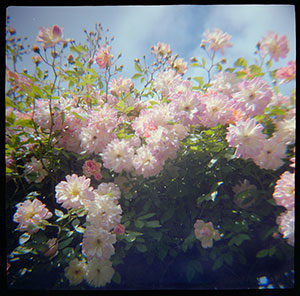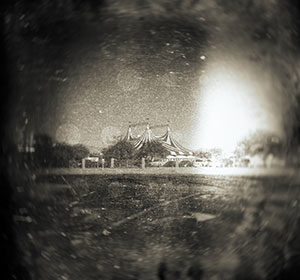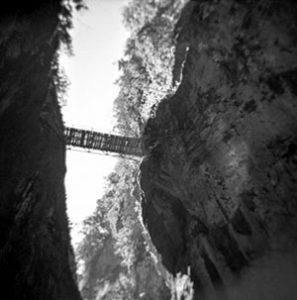
The Somerville Toy Camera Festival presented works such as Mary Kocol’s “English Roses” at the Brickbottom Gallery’s opening on September 8. — Photo by Mary Kocol
By Shira Laucharoen
Light leaks, blurs, and double exposures might not seem like desired effects to the untrained eye, but when seen through the lens of the toy camera, they create the image.
The Somerville Toy Camera Festival, now in its sixth year, asked artists to embrace the imperfections and assume a point of view, opening with three exhibitions where their photographs were put on display. With receptions at the Brickbottom Gallery, the Washington Street Art Center, and the Nave Gallery, on September 8 and 9, the Festival allowed for an element of play.
Toy cameras are simpler to operate than regular cameras and give the photographer less control over the amount of light in the image. They use a plastic lens that results in distortions and vignettes, and they do not have a shutter speed or aperture. These qualities of the cameras produce unexpected accidents in their pictures, resulting in unique representations and spontaneous outcomes.
“With a regular camera, you want the shutter to be very accurate, so you can time the exposure of the film right, and you want the lens to be accurate, so you can get a clear image. You want the camera itself to be a good solid box that doesn’t let any light in except when you take a picture. The toy camera is like a terrible version of all those things,” said co-founder of the Somerville Toy Camera Festival Lee Kilpatrick. “You have limited control over exposure and focus, you have erratic light leaks, and there are things that interfere that are artifacts of the way the camera is constructed. All those things together give a certain mood or feeling to the images, and that’s one of the things people like about them. There’s a happenstance aspect to them.”

Richard Bonvissuto’s “Circus Tent” was displayed at the Somerville Toy Camera Festival. — Photo by Richard Bonvissuto.
This year’s Festival brought together 127 photos by 70 artists, presenting work characterized by a dreamy, ethereal appearance, created through use of toy cameras. In her pastel toned English Roses, Mary Kocol achieves a colorful and otherworldly look at the flowers, capturing a slightly blurred view. Michael Weitzman produces a mysterious perspective in Man in Black Hat, a grainy profile of a man in a top hat, engulfed in a wisp of light. All contain a touch of nostalgia, an aspect of the old fashioned, as if invoking “a memory,” as explained by artist Lara Kimmerer. There is Richard Bonvissuto’s Circus Tent, a snapshot of a distant fair, and Sara Wilkerson’s Follows 4, where a woman in a dark dress stands still in a forest.
The toy camera was originally developed to be inexpensive and easy to use, produced in several models. Manufactured in the 1960s, the Diana was shipped out of Hong Kong and given away at carnivals and raffles, or used for promotional purposes. Called “the child” of the Diana by Festival juror Jennifer Shaw, the Holga, made in the 1980s, is known for its lack of precision and surreal pictures. The Lomo, originally built in Soviet-era Russia, is another popular one to use, while many photographers are known to work with the common Brownie snapshot cameras or homemade pinhole cameras, built from a cardboard box.
The Festival will continue until October 13, featuring events such as Shaw’s Solo Show and Artist Talk on September 16 and a Toy Camera Workshop with artist Bill Franson on September 23. Through the exhibits, Shaw said that the photos “transport the viewer,” taking him or her to a different space.
“When I transitioned to being a Holga photographer, I found that it really worked for me, the aesthetic, the way of seeing and shooting, and the way the pictures translated onto the film and felt psychologically,” said Shaw. “I felt that the camera was seeing the way I was seeing or interpreted the world the way I felt being in the world.”

Nick Seaney’s “Bridge Over Tolmin Gorge” was selected to be shown at the Festival. — Photo by Nick Seaney

 https://www.portersquarebooks.com/
https://www.portersquarebooks.com/













Reader Comments